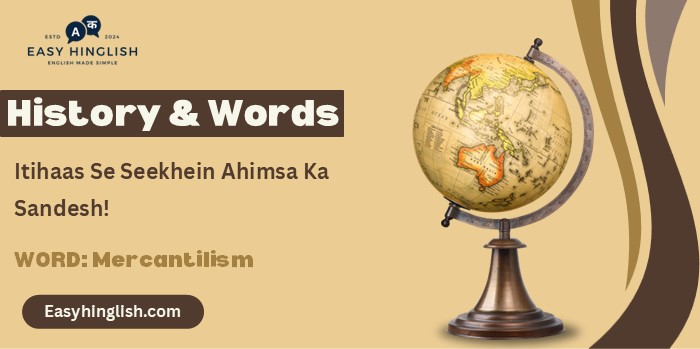History & Words: ‘Mercantilism’ (January 29)
Welcome to ‘History & Words.’ 🌟 Main Prashant hoon, founder of Wordpandit aur Learning Inc. Network. Ye series mere language learning ke junoon ko historical context ke sath jodti hai. Har entry ek word ka mahatva explore karti hai ek specific tareekh par, jisse aapka vocabulary bhi badhta hai aur history ki samajh bhi gehri hoti hai. Mere sath is safar mein shabd aur samay ke raaste par chaliye.
📚 Table of Contents
🔍 Word of the Day: Mercantilism
🌍 Parichay (Introduction)
29 January 1819 ko Sir Stamford Raffles ne Singapore ko ek British trading post ke roop mein establish kiya. Yeh sirf ek chhoti si fishing village ka badlav nahi tha, balki ek aisa kadam tha jo mercantilism ke ideas ko duniya ke ek naye kone mein le gaya — aur Singapore ko banaya ek global commercial hub.
“Mercantilism” ek economic theory nahi, balki ek national economic policy system tha jo 16th se 18th century tak Europe mein dominant raha. Iska main idea tha — trade ek zero-sum game hai: agar ek nation jeet raha hai, toh doosra haar raha hai. Isliye nations colonies banakar, trade control karke aur resources capture karke apni power badhane lage.
🌱 Shabd ka Utpatti (Etymology)
“Mercantilism” shabd aaya hai Latin ke words “mercans” (merchant) aur “mercari” (to trade) se. Yeh term 18th century mein Victor de Riqueti ne coin kiya tha, aur baad mein Adam Smith ne isse apni kitab The Wealth of Nations (1776) mein critique kiya.
📖 Mahatvapurn Shabdavali (Key Vocabulary)
- 🔑 East India Company: British ka powerful trading company, jo mercantilism ka practical example thi.
- 🔑 Balance of Trade: Export aur import ka difference; mercantilism mein positive trade balance zaroori mana jaata tha.
- 🔑 Navigation Acts: British laws jo colonies ke trade ko control karte the.
- 🔑 Bullionism: Mercantilist idea jisme national wealth ko gold aur silver ke amount se measure kiya jaata tha.
🏛️ Itihasik Sandarbh (Historical Context)
Mercantilism tab ubhra jab feudalism decline ho raha tha aur nation-states rise kar rahe the. New World ki discovery aur colonies banne ke baad European nations ne trade aur wealth ke liye naval aur colonial expansion start kiya.
East India Company jaise institutions ne mercantilism ke ideas ko real world mein implement kiya — trade monopolies banakar, military power se ports control karke, aur apni economy ke liye colonies ko use karke.
Singapore ka establishment bhi isi system ka part tha — jahan British ne ek strategic point ko capture kiya jisse unka control Strait of Malacca ke upar ho gaya.
⏳ Samayrekha (Timeline)
- 1600 – British East India Company ki shuruaat
- 1602 – Dutch East India Company established
- 1651 – Pehla Navigation Act pass hua
- 1664 – French East India Company start hui
- 1773 – Tea Act: British monopoly aur strong hui
- 1819 – Singapore established as British trading post
- 1824 – Anglo-Dutch Treaty ne Singapore ko British control mein confirm kiya
- 1833 – China ke saath trade par East India Company ka monopoly khatam
🌟 Is Din ka Mahatva (The Day’s Significance)
29 January 1819 ka din important isliye hai kyunki Sir Stamford Raffles ne Singapore ko ek key trade point banaya. Yeh step tha mercantilist planning ka part — jisme ek perfect location capture karke Britain ne Asia ke trade par apna control badhaya.
Strait of Malacca ka control lena matlab Asia ke trade routes pe dominance establish karna. Is move se Dutch control ko challenge bhi kiya gaya.
Interestingly, Raffles ne free trade ka model bhi implement kiya — jisse Singapore ek multi-national commercial hub ban gaya jo British interest serve karta tha lekin sab merchants ke liye khula tha.
💬 Prasiddh Ukti (Quote)
“Commerce is the key which will open to us the hearts of the Native States of the Eastern Seas.”
— Sir Stamford Raffles, 1819
🔮 Aaj Ka Matlab aur Chintan (Modern Usage and Reflection)
Aaj bhi “mercantilism” ka use hota hai jab log trade wars, protectionism aur economic nationalism ki baat karte hain. Countries jab tariffs ya exports ko promote karti hain, toh unke policies often neo-mercantilist kehlaate hain.
Singapore ka model dikhata hai ki strategic trade control ke baad bhi agar open market policies apply ki jaayein, toh ek colonial trading post bhi global financial power ban sakti hai.
🏛️ Virast (Legacy)
Mercantilism ne global trade ke basic concepts establish kiye — jaise trade statistics ka role, government intervention, aur strategic location ka economic importance.
Aaj ke international trade structures — jaise ports, trade companies, aur financial institutions — sab ki jaden mercantilist period se judi hui hain.
🔍 Tulnatmak Vishleshan (Comparative Analysis)
Old mercantilism focused hota tha state control aur strict trade policies pe. Aaj ka economic nationalism ek hybrid hai — jahan market-oriented reforms ke sath sath kuch protectionist elements bhi use kiye jaate hain.
Singapore ka model dikhata hai ki ek mercantilist base par bhi modern economic powerhouse banaya jaa sakta hai.
💡 Kya Aapko Pata Hai? (Did You Know?)
🎓 Antim Vichar (Conclusion)
29 January 1819 ko jab Singapore ek British trading post bana, tab usne mercantilism ka ek real-world demonstration diya. Aaj jab hum global trade aur economic policy ki baat karte hain, toh humein yeh yaad rakhna chahiye ki kai current systems ka base mercantilist era mein hi pada tha.
📚 Aage Padhne Ke Liye (Further Reading)
- 📘 Cities of Commerce – Oscar Gelderblom
- 📗 Singapore: A Modern History – Michael D. Barr
- 📙 The History of British India – James Mill








